
A strong product marketing portfolio is the best way to show recruiters what you’re capable of – in fact, it’s often the deciding factor in hiring decisions.
But what should you include in your portfolio? Which platform should you use to build it? What pitfalls should you avoid?
This guide answers all these questions and more. Plus, we’ll explore some real-world examples of product marketing portfolios – and tips on creating them – from seasoned product marketing professionals.
There’s even a bonus Q&A from Bianca Stanescu, Senior Director of Product Marketing at AdsWizz, who has not only created her own portfolio but assessed other PMMs’ portfolios as a hiring manager.
So, sit back, strap in, and get ready to showcase your expertise, as we uncover everything you need to know about the art of creating a product marketing portfolio.
What to include in your PMM portfolio
Your portfolio is the ultimate showcase of your work. But what exactly do you put in there? Let’s break it down.
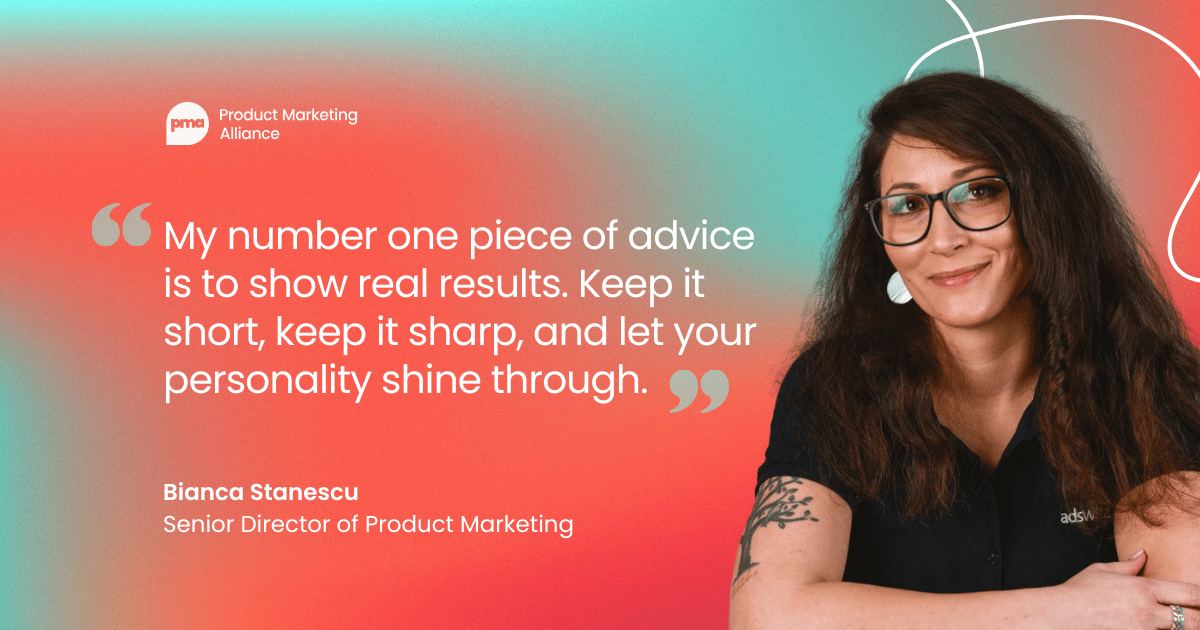
1. Your bio
You’ll want to include a short summary of who you are, your background, and your unique combination of skills and experience.
This is also a great place to mention the types of companies and industries you’ve worked in (B2B, SaaS, tech startups, etc.) to showcase your breadth of experience.
And why not include a photo of yourself? It adds a personal touch and makes you more than just a name on a screen.
2. Key product marketing skills
A list of your core marketing competencies, such as go-to-market strategy, storytelling, data analysis, and positioning, can be super helpful. This ensures recruiters can quickly see if you have the skills they’re looking for.
Not sure what your greatest product marketing strengths are? Take the Product Marketing IQ Test.
3. Detailed case studies and deliverables
This is the core of your portfolio – where you get to show off your work. This section is all about providing context, quantifying results, and linking to the actual deliverables for your major product marketing accomplishments.
You’ll want to aim for a mix of different project types that demonstrate your diverse PMM skill set. If possible, include one example for at least four of these categories:
- Product narrative, positioning, and messaging: This is where you can showcase your work on unifying messaging for products or positioning a company and its products in the market.
- Go-to-market (GTM) strategy: Show how you built and executed GTM strategies, including positioning frameworks, competitive battlecards, and ROI narratives.
- Demand generation and awareness: Highlight campaigns you’ve worked on that were focused on driving interest and visibility.
- Sales enablement: Demonstrate your ability to create tools and content that empower sales teams.
- Content marketing and thought leadership: Show off the articles, videos, and other content you’ve developed to establish industry expertise and influence.
- Establishing PMM functions: If you’ve built and scaled product marketing teams and processes from the ground up, this is the place to talk about it.
- Customer education: Feature programs you’ve created for customer adoption and support, like product video programs and comprehensive knowledge bases.
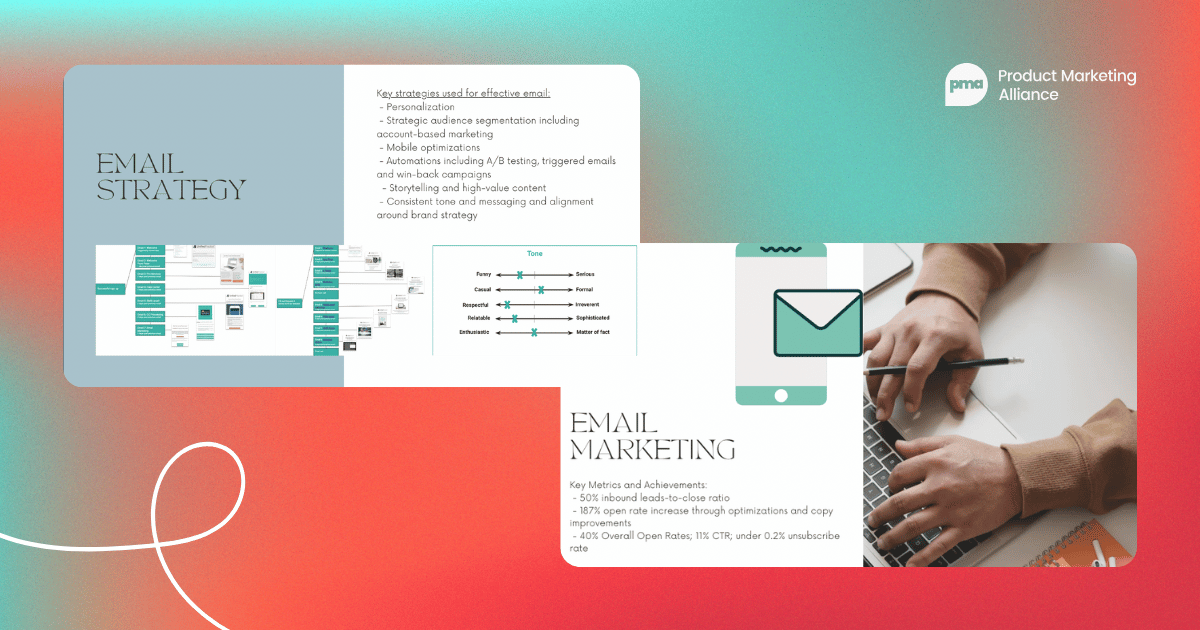
For each project, make sure you cover the following:
- The challenge or context: What problem were you trying to solve?
- Your approach: How did you address the challenge?
- The results: What were the measurable outcomes of your work? (Think adoption by recognized brands, a reduction in support tickets, or faster launch cycles.)
- The deliverables: Link to the actual work products, such as customer-facing content (ebooks, info sheets, playbooks), webinars, videos, or articles.
4. Testimonials and recommendations
Don’t underestimate the power of a good quote from a colleague, client, manager, or industry influencer. Include quotes that speak to your leadership, strategic thinking, collaboration skills, and ability to deliver results. It adds serious credibility and social proof.
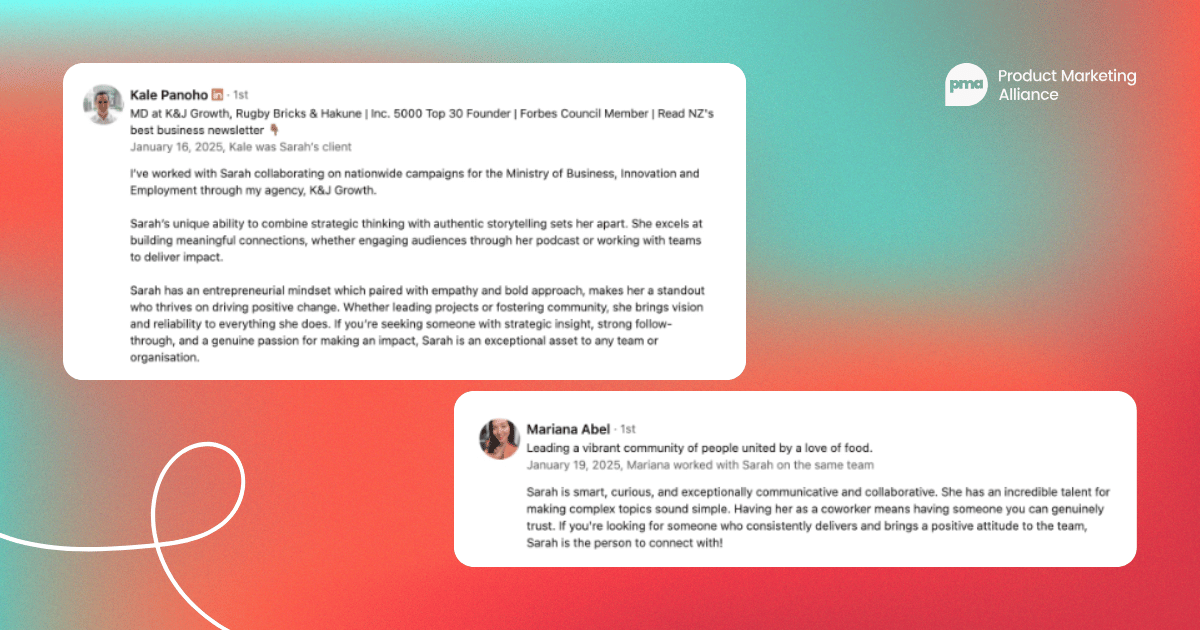
5. Extra-curriculars and community involvement
This is your chance to show more of your personality and passion. Have you completed a product marketing certification? Mentored a budding PMM? Lead a local PMM meetup? Drop it in your portfolio! It tells recruiters that you’re proactive and invested in your craft.
6. Contact information
Include your email and a link to your LinkedIn profile to make it easy for hiring managers to get in touch. Don’t make them work for it!
Top tools for creating a PMM portfolio
“We’re not designers, so don’t overthink the tool,” Bianca Stanescu says. “A light website, Canva, Notion, a video – take your pick. But try not to show up with a raw Google Doc of links. That’s not a portfolio, that’s homework.” We couldn’t agree more.
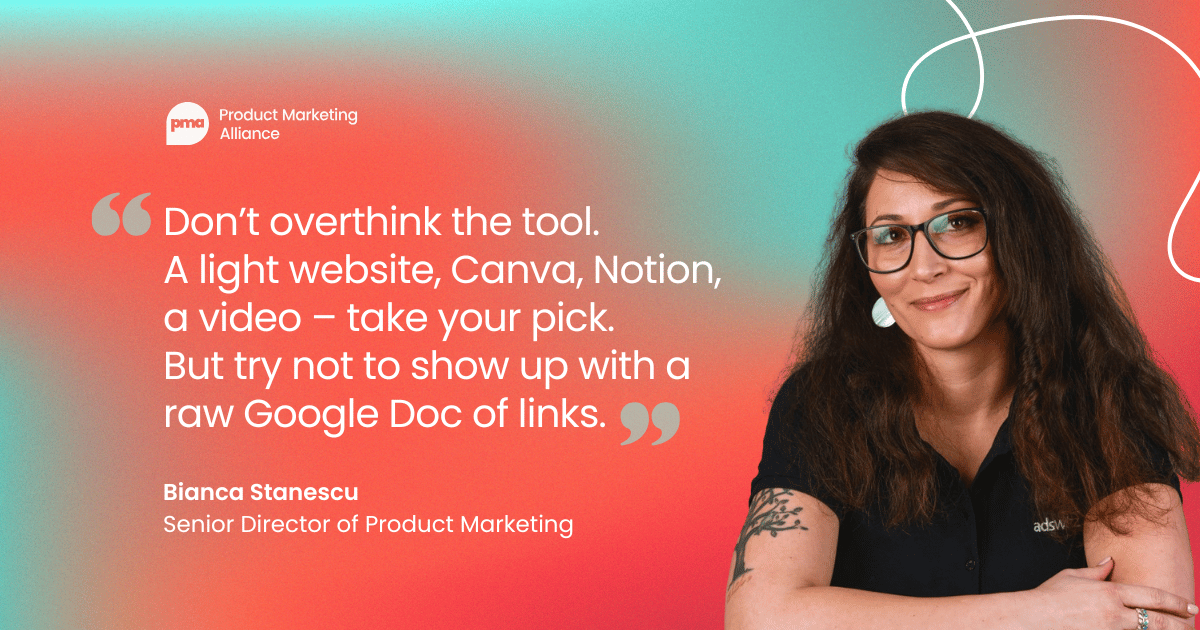
The good news is, you’ve got plenty of great options.
Canva
Canva is the go-to tool for amateur graphic designers, and it’s super intuitive and easy to use. Even its free features are impressive, but the pro features (like the photo background eraser and Magic Expand) can help you create something seriously polished. Plus, you can publish your portfolio as a website or download it as a PDF.
Susanna Bogardus, Principal Product Marketing Manager at Workday, created her portfolio using Canva, and we love how she showcases her many product marketing accomplishments in such a gorgeous layout.
Google Slides
Google Slides gives you some great templates to get you started and is highly customizable. However, it’s tricky to get an at-a-glance overview in the way you can with a website builder or Notion. As a viewer, it can feel a little clunky.
Notion
Notion offers a clean, simple design where readers can see everything at a glance and then click into the projects they want to learn more about.
If you decide to build your portfolio in Notion, Stefanos Karakasis has created a great template to get you started.
Website builders
From Wix and Squarespace to Webflow and WordPress, there are tons of platforms that enable you to build a beautiful portfolio website. Whichever platform you choose, just be sure to heed April Samuelson’s advice and get domain privacy protection – or risk being bombarded with spam.
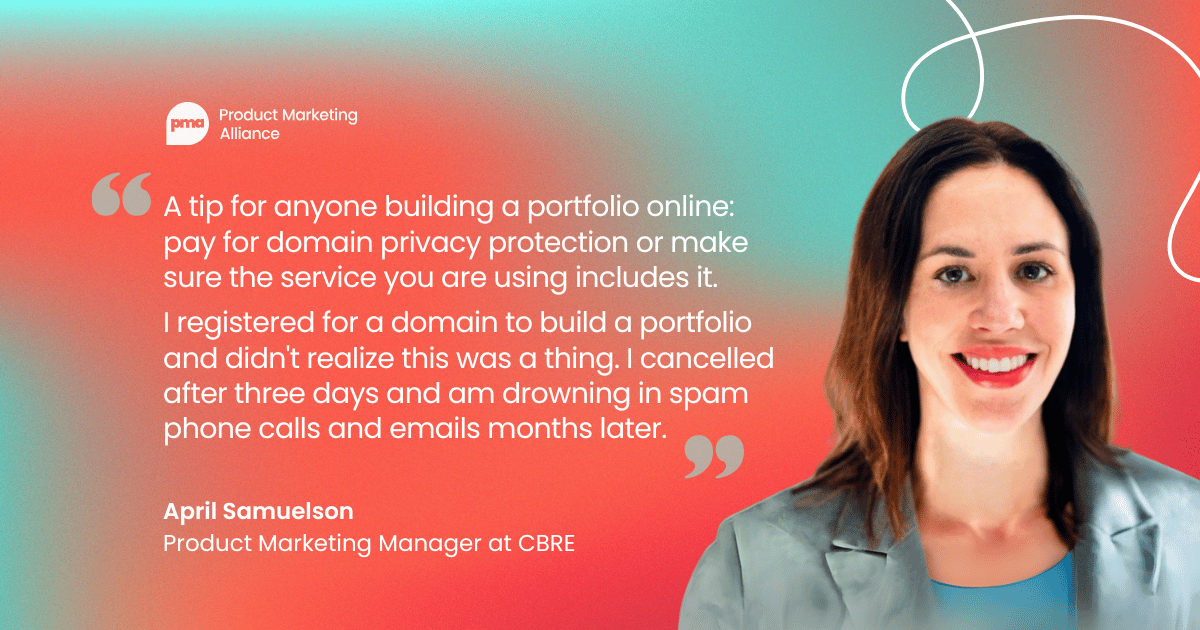
Q&A with Bianca Stanescu: Building a PMM portfolio that actually works
We sat down with seasoned product marketing leader Bianca Stanescu to pick her brains about how to approach your portfolio. Here are the insights she shared.
Why should product marketers even bother with a portfolio?
Portfolios for product marketers are no longer a nice-to-have – they’re the new currency. A ten-page resume isn’t proof of impact; it’s proof you’ve mastered bullet points. I once shrank mine into a one-pager (that PMMs notoriously despise), and lived to tell the tale. It had to be done!
Back in the day, portfolios were for designers and writers. Today, if you’re in product marketing without one, you’re the equivalent of a restaurant with no menu. The recruiter might still eat there, but the odds aren’t in your favor.
What makes a strong portfolio stand out?
My number one piece of advice is to show real results. Keep it short, keep it sharp, and let a bit of your personality shine through. Think of your portfolio as the trailer, not the movie. It should complement your resume, not duplicate it. No one ever said, ‘Wow, I loved watching the same scene twice.’
Does the format or tool matter?
We’re not designers, so don’t overthink the tool. Website, Canva, Notion – take your pick. Just please, don’t show up with a raw Google Doc of links. That’s not a portfolio, that’s homework. The look and feel should still match your personality and your vibe. Expectations are lower than for designers, but consistency goes a long way.
Any privacy or longevity concerns?
Spending four years in cybersecurity ruined me for life. Now every portfolio looks like a phishing scam waiting to happen. Share enough to showcase your work, but don’t hand over your company’s crown jewels (or your own).
Screenshots and PDFs age better than broken links. That shiny eGuide link from three years ago will probably be a 404 soon. Screenshot, archive, and save your receipts. Your future self will thank you.
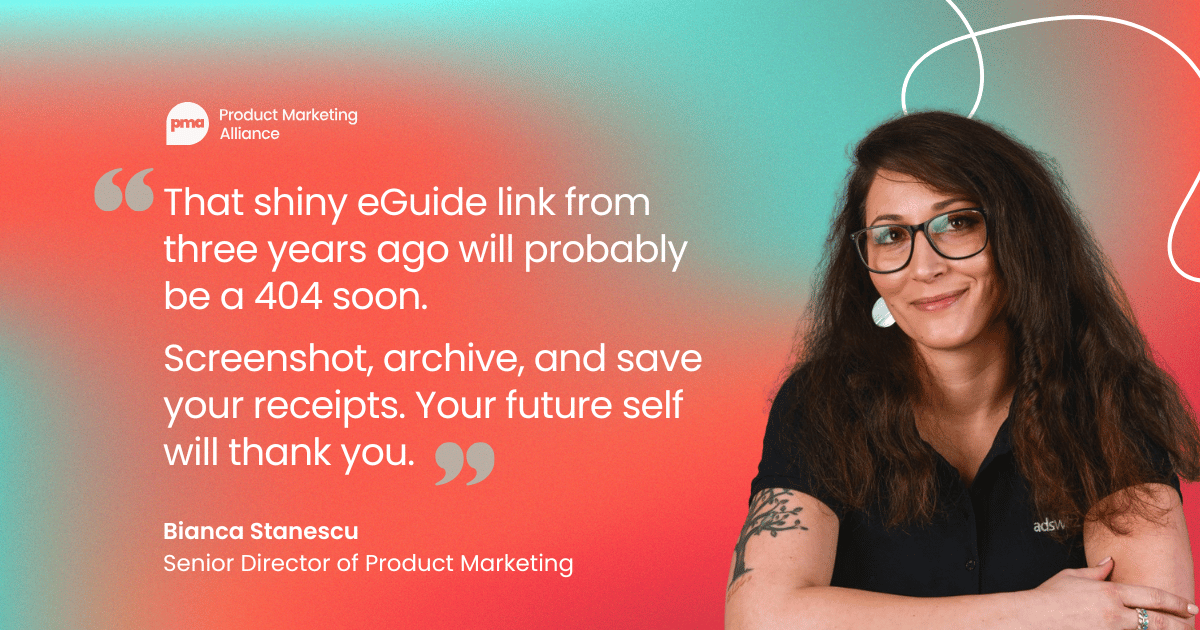
How about more senior PMMs? Portfolios must get harder as you move up the ladder.
Exactly. As you climb the corporate ladder, portfolios get trickier. You can’t exactly upload a screenshot of ‘influenced company strategy’ or ‘fixed the org structure.’ Our OKRs are vague by design, our work is cross-functional, and the outcomes are rarely just ours.
That’s why I use the CEO/sales test: if my former employer’s CEO or sales team read this, would they recognize it as true and attributable? If yes, it belongs in your portfolio.
You’ve led teams and hired PMMs. What did portfolios tell you as a recruiter?
I’ve been leading and hiring PMMs for over six years now, and portfolios are often the deciding factor, especially in product-led growth roles. I look closely at how candidates distill complex work into something clear, compelling, and not drowning in jargon. That skill alone tells me how they’ll communicate inside the org.
That’s a wrap!
We hope this guide has given you a solid foundation for creating or updating your own portfolio.
Now, it’s your turn. What are your best portfolio tips? Drop them in the comments and help out your fellow PMMs.


